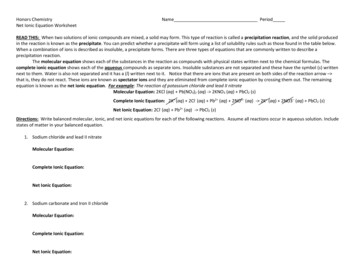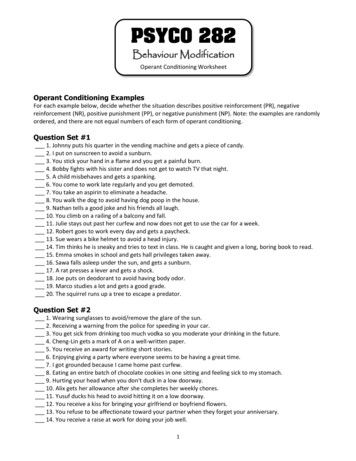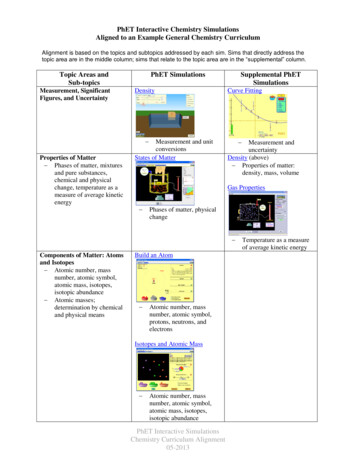
Transcription
Honors ChemistryNet Ionic Equation WorksheetName PeriodREAD THIS: When two solutions of ionic compounds are mixed, a solid may form. This type of reaction is called a precipitation reaction, and the solid producedin the reaction is known as the precipitate. You can predict whether a precipitate will form using a list of solubility rules such as those found in the table below.When a combination of ions is described as insoluble, a precipitate forms. There are three types of equations that are commonly written to describe aprecipitation reaction.The molecular equation shows each of the substances in the reaction as compounds with physical states written next to the chemical formulas. Thecomplete ionic equation shows each of the aqueous compounds as separate ions. Insoluble substances are not separated and these have the symbol (s) writtennext to them. Water is also not separated and it has a (l) written next to it. Notice that there are ions that are present on both sides of the reaction arrow – that is, they do not react. These ions are known as spectator ions and they are eliminated from complete ionic equation by crossing them out. The remainingequation is known as the net ionic equation. For example: The reaction of potassium chloride and lead II nitrateMolecular Equation: 2KCl (aq) Pb(NO3)2 (aq) - 2KNO3 (aq) PbCl2 (s)Complete Ionic Equation: 2K (aq) 2Cl- (aq) Pb2 (aq) 2NO3– (aq) - 2K (aq) 2NO3– (aq) PbCl2 (s)Net Ionic Equation: 2Cl- (aq) Pb2 (aq) - PbCl2 (s)Directions: Write balanced molecular, ionic, and net ionic equations for each of the following reactions. Assume all reactions occur in aqueous solution. Includestates of matter in your balanced equation.1. Sodium chloride and lead II nitrateMolecular Equation:Complete Ionic Equation:Net Ionic Equation:2. Sodium carbonate and Iron II chlorideMolecular Equation:Complete Ionic Equation:Net Ionic Equation:
3. Magnesium hydroxide and hydrochloric acidMolecular Equation:Complete Ionic Equation:Net Ionic Equation:4. Potassium chromate and calcium chlorideMolecular Equation:Complete Ionic Equation:Net Ionic Equation:5. Ammonium phosphate and zinc nitrateMolecular Equation:Complete Ionic Equation:Net Ionic Equation:6. Lithium hydroxide and barium chlorideMolecular Equation:Complete Ionic Equation:Net Ionic Equation:
7. Sodium carbonate and hydrochloric acid produces sodium chloride, carbon dioxide and waterMolecular Equation:Complete Ionic Equation:Net Ionic Equation:8. Magnesium nitrate and sodium chromateMolecular Equation:Complete Ionic Equation:Net Ionic Equation:9. Iron III chloride and magnesium metalMolecular Equation:Complete Ionic Equation:Net Ionic Equation:10. Barium Bromide and sodium sulfateMolecular Equation:Complete Ionic Equation:Net Ionic Equation:
11. Silver nitrate and magnesium iodideMolecular Equation:Complete Ionic Equation:Net Ionic Equation:12. Ammonium chromate and aluminum perchlorateMolecular Equation:Complete Ionic Equation:Net Ionic Equation:13. Nickel nitrate and sodium hydroxideMolecular Equation:Complete Ionic Equation:Net Ionic Equation:
14. Hydrobromic acid (HBr) and lead II perchlorateMolecular Equation:Complete Ionic Equation:Net Ionic Equation:15. Potassium fluoride and magnesium nitrateMolecular Equation:Complete Ionic Equation:Net Ionic Equation:16. Sodium phosphate and nickel II perchlorateMolecular Equation:Complete Ionic Equation:Net Ionic Equation:17. Copper II chloride and silver acetateMolecular Equation:Complete Ionic Equation:Net Ionic Equation:
Net Ionic Equation Worksheet - answers1. Molecular Equation: 2NaCl(aq) Pb(NO3)2(aq) PbCl2(s) 2NaNO3(aq)Ionic Equation:2Na (aq) 2Cl-(aq) Pb2 (aq) 2NO3-(aq) PbCl2(s) 2Na (aq) 2NO3-(aq)NIE:2Cl-(aq) Pb2 (aq) PbCl2(s)2. Molecular Equation: Na2CO3(aq) FeCl2(aq) FeCO3(s) 2NaCl(aq)Ionic Equation:2Na (aq) CO32-(aq) Fe2 (aq) 2Cl-(aq) FeCO3(s) 2Na (aq) 2 Cl-(aq)NIE:CO32-(aq) Fe2 (aq) FeCO3(s)3. Molecular Equation: Mg(OH)2(aq) 2HCl(aq) MgCl2(aq) 2 H2O(l)Ionic Equation:Mg2 (aq) 2 OH-(aq) 2 H (aq) 2 Cl-(aq) Mg2 (aq) 2 Cl-(aq) 2 H2O(l)NIE:2 OH-(aq) 2 H (aq) 2 H2O(l)(your final answer would be: OH-(aq) H (aq) H2O(l) )4. Molecular Equation: K2CrO4 (aq) CaCl2 (aq) 2 KCl(aq) CaCrO4 (aq)Ionic Equation:2 K (aq) CrO42-(aq) Ca2 (aq) 2Cl-(aq) 2 K (aq) 2 Cl-(aq) Ca2 CrO42NIE:N/A, all spectator ions5. Molecular Equation: 2 (NH4)3PO4(aq) 3 Zn(NO3)2(aq) 6 NH4NO3(aq) Zn3(PO4)2(s)Ionic Equation:6 NH4 (aq) 2 PO43-(aq) 3 Zn2 (aq) 6 NO3-(aq) 6 NH4 (aq) 6NO3-(aq) Zn3(PO4)2(s)NIE:2 PO43-(aq) 3 Zn2 (aq) Zn3(PO4)2(s)6. Molecular Equation: 2 LiOH(aq) BaCl2(aq) 2 LiCl(aq) Ba(OH)2(aq)Ionic Equation:2 Li (aq) 2 OH-(aq) Ba2 (aq) 2 Cl-(aq) 2 Li (aq) 2 Cl-(aq) Ba2 2 OHNIE:N/A, all spectator ions7. Molecular Equation: Na2CO3(aq) 2 HCl(aq) 2 NaCl(aq) CO2(g) H2O(l) 2 Ionic Equation:2 Na (aq) CO3 (aq) 2 H (aq) 2 Cl (aq) 2 Na (aq) 2 Cl-(aq) CO2(g) H2O(l)NIE:CO32-(aq) 2 H (aq) CO2(g) H2O(l)8. Molecular Equation: Mg(NO3)2(aq) Na2CrO4(aq) 2NaNO3(aq) MgCrO4(s)Ionic Equation:Mg2 (aq) 2 NO3-(aq) 2 Na (aq) CrO42-(aq) 2 Na (aq) 2 NO3-(aq) MgCrO4(s)NIE:Mg2 (aq) CrO42-(aq) MgCrO4(s)
9. Molecular Equation: 2 FeCl3(aq) 3 Mg(s) 3 MgCl2(aq) 2 Fe(s)Ionic Equation:2 Fe3 (aq) 6 Cl-(aq) 3 Mg(s) 3 Mg2 (aq) 6 Cl-(aq) 2 Fe(s)NIE:2 Fe3 (aq) 3 Mg(s) 3 Mg2 (aq) 2 Fe(s)10. Molecular Equation: BaBr2(aq) Na2SO4(aq) BaSO4(s) 2 NaBr(aq)Ionic Equation:Ba2 (aq) 2 Br-(aq) 2 Na (aq) SO42-(aq) BaSO4(s) 2 Na (aq) 2 Br-(aq)NIE:Ba2 (aq) SO42-(aq) BaSO4(s)11. Molecular Equation: 2 AgNO3(aq) MgI2(aq) 2 AgI(s) Mg(NO3)2(aq)Ionic Equation:2 Ag (aq) 2 NO3-(aq) Mg2 (aq) 2 I-(aq) 2 AgI(s) Mg2 (aq) 2 NO3-(aq)NIE:2 Ag (aq) 2 I-(aq) 2 AgI(s)(your final answer would be: Ag (aq) I-(aq) AgI(s) )12. Molecular Equation: 3 (NH4)2CrO4(aq) 2 Al(ClO4)3(aq) Al2(CrO4)3(s) 6 NH4ClO4(aq)Ionic Equation:6 NH4 (aq) 3 CrO42-(aq) 2 Al3 (aq) 6 ClO4-(aq) 6 NH4 (aq) 6 ClO4-(aq) Al2(CrO4)3(s)NIE:3 C2O42-(aq) 2 Al3 (aq) Al2(CrO4)3(s)13. Molecular Equation: Ni(NO3)2(aq) 2 NaOH(aq) Ni(OH)2(s) 2 NaNO3(aq)Ionic Equation:Ni2 (aq) 2 NO3-(aq) 2 Na (aq) 2 OH-(aq) Ni(OH)2(s) 2 Na (aq) NO3-(aq)NIE:Ni2 (aq) 2 OH-(aq) Ni(OH)2(s)14. Molecular Equation: 2 HBr(aq) Pb(ClO4)2(aq) 2 HClO4(aq) PbBr2(s)Ionic Equation:2 H (aq) 2 Br-(aq) Pb2 (aq) 2ClO4-(aq) 2H (aq) 2 ClO4-(aq) PbBr2(s)NIE:2 Br-(aq) Pb2 (aq) PbBr2(s)15. Molecular Equation: 2 KF(aq) Mg(NO3)2(aq) 2 KNO3(aq) MgF2(s)Ionic Equation:2 K (aq) 2 F-(aq) Mg2 (aq) 2NO3-(aq) 2 K (aq) 2 NO3-(aq) MgF2(s)NIE:2 F-(aq) Mg2 (aq) MgF2(s)16. Molecular Equation: 2 Na3PO4(aq) 3 Ni(ClO4)2(aq) 6 NaClO4(aq) Ni3(PO4)2(s)Ionic Equation:6 Na (aq) 2 PO43-(aq) 3 Ni2 (aq) 6 ClO4-(aq) 6 Na (aq) 6 ClO4-(aq) Ni3(PO4)2(s)NIE:2 PO43-(aq) 3 Ni2 (aq) Ni3(PO4)2(s)17. Molecular Equation: CuCl2(aq) 2 AgC2H3O2(aq) Cu(C2H3O2)2(aq) 2 AgCl(s)Ionic Equation:Cu2 (aq) 2 Cl-(aq) 2 Ag (aq) 2 C2H3O2-(aq) Cu2 (aq) 2 C2H3O2-(aq) 2 AgCl(s)NIE:Cl-(aq) Ag (aq) AgCl(s)
Honors Chemistry Name_ Period_ Net Ionic Equation Worksheet READ THIS: When two solutions of ionic compounds are mixed, a solid may form. This type of reaction is called a precipitation reaction, and the solid produced in the reaction is known as the precipitate.You can predict whether a precipitate will form using a list of solubility rules such as those found in the table below.










